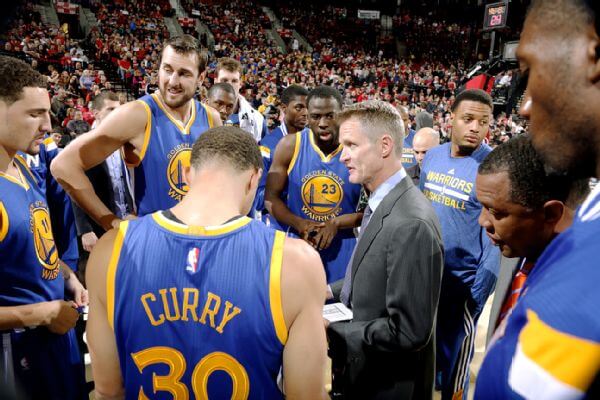Today a guest post from Bruce Peters of Beyond Teal, who is based in upstate New York. His post is on leadership lessons from elite sports, a recurring theme on this site. Thank you to Bruce for allowing me to share this with you here.
Bruce is a remarkable human being that I’ve had the absolute pleasure and privilege to get to know over the last year. Our initial connection is around “Teal”, around the future of organisations. For more, go to the post: “Books I Love – Reinventing Organisations by Frederic Laloux“. Bruce is a warm, kind, generous man with an absolute wealth of knowledge in business and leadership, and full of energy and curiosity!

Winning at Halftime
If winning is your business goal, how can you help your team do it?
As you may know by now, I’m a sports fan, generally, and an avid follower of the Golden State Warriors (GSW), specifically. In case you didn’t follow the drama of the 2018 NBA Championships, GSW won. They play like no other team. Indeed, they actually play as a team, something their competition has yet to understand.
The origins of my attention on GSW goes back to me following them when they were based in Philadelphia near where I grew up. My continued and professional fascination with the team relates to how they play the game. I won’t bother you with the details of how they are Teal-like. I do, however, want to pass along this article from The New York Times, “Why Do the Warriors Dominate the 3rd Quarter? Consider Their Halftime Drill.”
As the name suggests, the article is about the GSW’s process of what they do during half-time of each game. The genesis of the article was their extraordinary performance in the third quarter during the entire season and 2018 championship series. In fact, the GSW are known for their astounding third quarter performances. So much so, that by the end of most third quarters the game is essentially won.
GSW leverages what they have learned in the first half of the game to execute a higher performance, often for the win, in the third quarter.
People want to know, what is the team doing during halftime that might account for that third quarter? Is there anything that could be learned from GSW practices?
The GSW 15-minute halftime routine goes a bit like this:
- The Coach (Steve Kerr) and his assistants meet on their own for a few minutes to discuss the game’s first two quarters. They review video clips of moments. These clips are collected by everyone, assistants, Kerr, and all players, including those who did not have play in the first half. Everyone has input on what needs to be highlighted.
- Meanwhile, the players do their personal rituals, change a jersey, check their phones, whatever. It’s their time.
- Kerr speaks to the team. He shows clips emphasizing what the team does right during the first half.
- The assistant coach speaks.
- The discussion is open for any input from the team. Input from those who did not play in the first half is valued because they offer a very distinct and needed perspective. This is important, remember it.
- The team is adjourned with at least six minutes remaining in halftime for players to warm-up for the second half.
- They return to court almost as a new team, adjusting, closing point deficits, and usually winning the game.
It also helps to know that GSW players keep their ego out of the way. While most teams play to and around their star players, GSW does not. Passing and sharing the ball is encouraged and rewarded. GSW players play with a shared purpose to win, not pad their personal resume with points. {note from Tom, link to a similar theme on the San Antonio Spurs in: Humble Leadership – “that’s family business”}
Everyone has a role. Remember those players who did not play the first half, whose input is valued? Because these players are mentally invested and part of the game, they immediately fit in with the teamwork on the court, should they be asked to play. They are ready to play because they have been part of the entire game.
The GSW play almost 100 games per year. Every single game is a performance and halftime is a performance review. They assess, check, adjust, sense, and respond to how they are doing against the current competition.
This is the ultimate example of dexterity and quick response on a team level.
Your Halftime
I know you recently went through your annual mid-year meeting. This is your semi-annual halftime. How can you bring the GSW dexterity to your team?
Do as GSW does.
Create an organic flow of the work. (This is the GSW first and second quarter).
- Maximize everyone’s talent.
- Value and accept everyone’s input.
- Keep everyone involved.
- Keep your ego out of the way.
What else could be the individual or organizational version of this? I don’t know of anyone who takes a daily halftime and uses it to sense, adjust, and respond to the first half of the day. If you already do a daily huddle, what might happen if your team’s daily huddle was shifted to the middle of the day and restricted to 15 minutes?
It’s game time.
